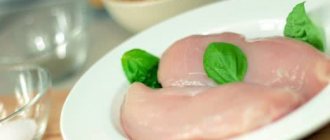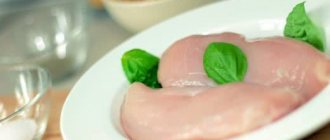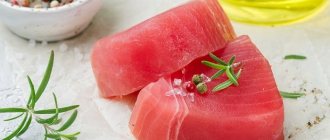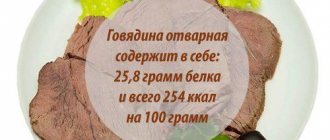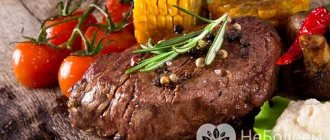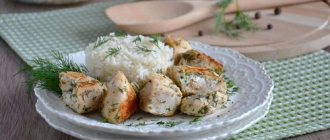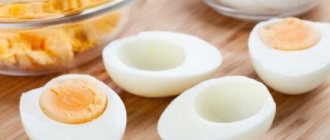Nutritional value of athletes
A bodybuilder and chicken breast are an inseparable tandem. Bodybuilders and supporters of a healthy diet are well aware of the high protein content of chicken breast, which is why they so value its properties and richness in amino acids and protein compounds. In addition to protein, a wide range of vitamins, minerals and microelements is also of great value.
In bodybuilding, protein is used from natural products, and nutritional supplements with a large number of amino acids are also popular. Whichever source is preferred, protein products help increase the number of muscle fibers and make them better quality.
Proteins as the basis for growth and vital activity
Eating protein is the main way to obtain amino acids important for life. During the digestion process, foreign proteins are destroyed, after which they enter the acidic gastric environment, and are then exposed to enzymes. Proteins are broken down into amino acids: some of them are used to support the synthesis of their own molecules, and the rest, under the influence of chemical reactions, are broken down into glucose, which is an energy source.
Proteins play an important role in the full functioning of cells and the body as a whole. With their help, the main functions are performed:
- transport;
- motor;
- receptor;
- protective;
- signal;
- regulatory;
- enzymatic.
BJU content per 100 grams of chicken fillet
Chicken fillet is a dietary product. Knowing how much protein is in the breast, you can easily calculate the required amount of product in grams and add it to your diet. The body's daily protein requirement is 80 grams.
To obtain the daily protein requirement, you need to consume about 300 grams of boiled chicken, which is recommended to be divided into several meals. The peculiarity of white meat is its fast and good absorption and versatility when maintaining a diet of any nature.
So, how much protein is contained in chicken breast fillet per 100 grams of product? Let's look at several cooking options as an example:
| Cooking method | Proteins, g | Fats, g | Carbohydrates, g |
| Raw | 23,6 | 1,9 | 0,4 |
| Boiled | 27,6 | 1,8 | 0,5 |
| For a couple | 23,6 | 1,9 | 0,1 |
| Fried | 25,2 | 7,8 | 1,3 |
| Baked | 24,8 | 1,6 | 0,4 |
| Grill | 19 | 7,1 | 4,1 |
| Smoked | 18 | 5 | 0,1 |
As you already understand, the final amount of protein in a chicken breast depends on the method of preparing the poultry meat. During heat treatment, meat loses about 20% of water, so from 100 g of product the output will be about 75-80 grams. Boiled chicken contains more grams of protein because... loses his weight.
In any case, 100 grams of chicken breast is a storehouse of protein, no matter how long it takes to cook.
Calorie content of boiled turkey fillet and chicken fillet
Turkey and chicken fillets are not only appreciated by many culinary specialists, but are also favorite products among most nutritionists and sports nutritionists. This is primarily due to the low calorie content of chicken fillet and idea.
Useful properties of turkey
The meat of this bird is distinguished not only by its wonderful taste, but also by its optimal protein and mineral composition, and is also a truly dietary product. Magnesium contained in turkey meat helps avoid problems with the nervous system, selenium prevents the development of cancer, and also has a rejuvenating and tonic effect. Poultry meat contains almost twice as much iron as beef, and phosphorus - almost the same amount as sea fish. With all these advantages, turkey is a low-calorie product, is easily absorbed by the human body and almost never causes allergic reactions.
Calorie content of turkey fillet and other nutritional indicators of poultry meat
On average, the calorie content of this bird is 195 kilocalories per 100 grams of product. It largely depends on the type of meat or type of offal, for example:
- 112 kilocalories – calorie content of turkey fillet;
- 125 kilocalories – the calorie content of a bird’s heart;
- 152 kilocalories – calorie content of poultry legs;
- 275 kilocalories – calorie content of turkey liver.
The calorie content of turkey fillet is the lowest compared to other parts of this bird. In addition, if you use breast without skin to prepare the dish, the calorie content of the product will be even lower - only 95 kilocalories per 100 grams of product. In this case, the calorie content of the boiled fillet will be 70-80 kilocalories - this is due to the fact that during the cooking process some of the calories remain in the broth.
Poultry fillet is rich in protein. On average, per 100 grams of product there are up to 22-30 grams of protein and up to 12 grams of fat, the remaining components are unsaturated fatty acids and water. The product is also valued for its low cholesterol content - up to 75-95 mg per 100 grams of product.
Poultry meat is considered an ideal basis for the preparation of therapeutic diets and diets for weight loss
Only those who must monitor the amount of protein in their diet should use this product with caution. For example, patients suffering from kidney failure, hypertension and gout should not eat turkey too often
And people with hypertension should also pay attention to the fact that poultry meat is rich in sodium, which means salt should be used in small quantities when preparing turkey dishes
Useful properties of chicken
Unlike turkey, chicken can be found in any store - be it a huge supermarket or a small grocery store. Chicken meat is rich in protein, B vitamins, phosphorus, magnesium, chromium, zinc and cobalt. The meat of this most famous bird in our area is higher in calories than turkey meat, but some of its parts are used in dietary nutrition - for example, chicken fillet.
A variety of poultry fillet dishes are favorites of many athletes. Being an excellent source of protein, chicken meat is not particularly fatty, which means it can be included in weight loss diets.
Calorie content of chicken fillet and poultry in general
On average, the calorie content of chicken is 240 kilocalories per 100 grams of product. The same amount of chicken meat contains up to 19 grams of protein, up to 20 grams of fat and up to 1 gram of carbohydrates; the rest of the bird is water.
The calorie content of chicken fillet is two times lower than that of poultry carcasses as a whole - it is 114 kilocalories per 100 grams of product.
Those who follow a diet should know that the best way to cook chicken fillet is to boil it. During the cooking process, some of the calories remain in the broth, so the calorie content of the boiled poultry fillet will be about 95 kilocalories. A noteworthy fact is that one hundred grams of boiled chicken fillet contains the daily requirement of cobalt for a person.
pohudanie.net
Calories and vitamins
The calorie content in raw skinless chicken breast is no more than 113 kcal per 100 grams of product. As with the protein content of chicken, calorie content depends on the method of preparing the fillet:
- boiled – 137 kcal;
- steamed – 113 kcal;
- fried – 161.8 kcal;
- baked – 119.3 kcal;
- grill – 166 kcal;
- smoked – 117 kcal.
Composition of meat elements in percentage:

Ready-made chicken dishes can be not only aromatic and tasty. They also contain a number of elements important for the body, B vitamins and more:
| Vitamins | Content in mg | Daily requirement in % |
| A1 | 0,073 | 7 |
| B1 | 0,06 | 4,5 |
| B2 | 0,8 | 4,3 |
| B4 | 74 | 14 |
| B5 | 0,85 | 10 |
| B6 | 0,42 | 23 |
| B9 | 0,0043 | 1,2 |
| B12 | 0,00062 | 0,25 |
| C | 1,85 | 3,2 |
| E | 0,19 | 1,5 |
| H | 0,009 | 21 |
| PP | 11,5 | 54,3 |
*Nutrients are indicated per 100 g of white meat.
In addition to the complex of vitamins, the composition includes minerals: magnesium 84.9 mg, sodium 62.3 mg, phosphorus 172.5 mg, chlorine 75.8 mg, calcium 9.4 mg and potassium 295 mg. And a number of microelements:
| Microelements | Content | Daily requirement in % |
| Iron | 1.81 mg | 9,3 |
| Iodine | 6.89 mcg | 4,7 |
| Cobalt | 13 mcg | 118 |
| Manganese | 0.03 mcg | 1,3 |
| Copper | 74 mcg | 8,3 |
| Fluorine | 0.13 mg | 8,5 |
| Chromium | 8.49 mcg | 19,2 |
| Zinc | 1.51 mcg | 16,8 |
Chemical composition and nutritional value
Chicken meat is considered dietary; it is considered an affordable source of quickly digestible protein. A quarter of the protein's weight is less than 2% fat, which makes chicken an ideal food product for athletes who are gaining muscle mass and people trying to lose extra pounds.
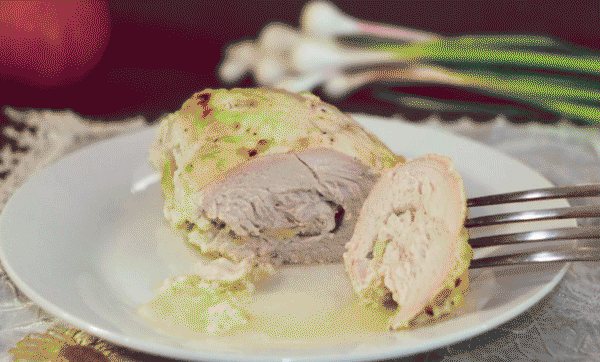
100 grams of raw meat contains 24 g of protein, 2 g of fat, 0.5 g of carbohydrates, 71 g of water and about 10 mg of cholesterol, as well as a sufficient amount of vitamins:
- niacin – 10.8 mg;
- B1 – 0.06 mg;
- B2 – 0.06 mg;
- RR – 7.7 mg.
Content of microelements per 100 g of product:
- iron – 1.3 mg;
- zinc – 1.3 mg;
- copper – 75 mcg;
- fluorine – 120 mcg;
- cobalt – 9 mcg;
- iodine – 5-6 mcg;
- molybdenum – 10 mcg;
- chromium – 23 mcg.
Macronutrients in chicken breast:
- potassium – 295 mg;
- phosphorus – 173 mg;
- magnesium – 80 mg;
- sodium – 66 mg;
- chlorine – 71 mg;
- calcium – 7.5 mg.
In addition to vitamins, micro- and macroelements, white meat contains a large number of non-essential and essential amino acids.
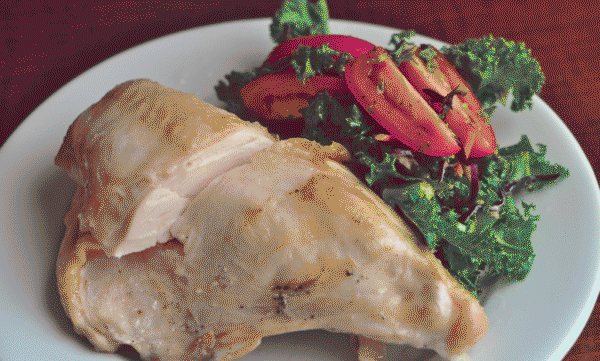
Here are some of them:
- tyrosine – 0.8 g;
- glycine – 0.9 g;
- alanine – 1.3 g;
- tryptophan – 0.35 g;
- lysine – 2.65 g;
- arginine – 1.8 g;
- histidine – 1.28 g;
- valine – 1.25 g;
- methionine – 0.4 g.
Meat also contains saturated and unsaturated fatty acids in small quantities, including omega-3, omega-6 and omega-9.
Unfortunately, with prolonged heat treatment, most of the beneficial nutrients decompose and the nutritional value of the breast decreases. Therefore, it is recommended to cook chicken in water, oven (without using oil) or steam for 20-30 minutes.
What part of chicken should you eat for maximum benefits?
Chicken is considered a popular ingredient in dishes around the world and comes in various parts: breast, drumsticks and thighs, wings and offal. The amount of calories, fat and protein per cut of meat varies quite a bit. Let's figure out how many grams of protein are in each of them.
What else are the benefits of chicken breast?
As you can see from the tables above, chicken breast fillet is rich not only in proteins, but also contains a large amount of microelements, vitamins and minerals. This is very important, because proper nutrition is not only about foods with a harmonious content of calories and nutrients. By receiving a full range of vital substances, the body maintains electrolyte balance and functions properly. When any of the elements is in deficiency, this is fraught with increased fatigue during the day, and especially during training, well-being noticeably worsens - all this significantly reduces the quality of life.
Another clear advantage of chicken meat is its ease of digestion and absorption without additional stress on the stomach. Any tasty and nutritious dish with breast can be served for dinner without worrying about heaviness in the stomach.

The dietary product contains little fat compared to red meat (beef, veal, lamb, pork). It also contains few carbohydrates. But the group of vitamins B is presented in abundance in fillets, which has a good effect on the condition of the skin and nervous system.
The obvious benefits and popularity of chicken breast are observed when following low-carb diets, since the amount of calories in the product is minimized. Unlike chicken drumsticks, wings and thighs, chicken fillet contains less fat, and the taste remains almost identical. Those who support healthy eating and bodybuilding know how much animal protein is found in chicken fillet, which makes this product an incredibly valuable element in their menu.
The value and components of chicken fillet
The most popular part of chicken is, of course, the breast. You already know very well how many calories and proteins are contained in 100 grams of skinless fillet: 113 calories, of which 80% comes from protein (23.6 g) and the remaining 20% from fat.
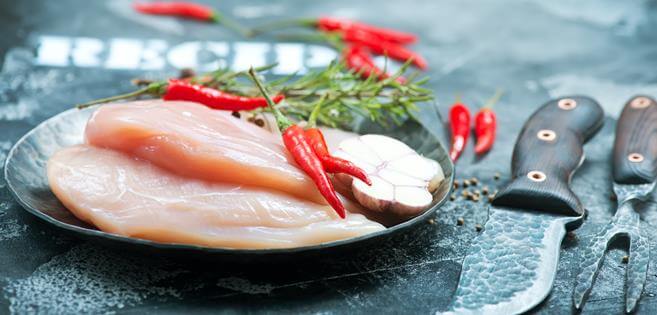
Such proportions make the product indispensable both for those who want to lose weight and for athletes gaining muscle mass.
Chicken thigh
There are 181 calories per 100 grams of thigh, 19.6 g of protein, 0.5 g of carbohydrates and 11 g of fat. Those. 63% of calories come from protein, 35% from fat, 2% from carbohydrates.
Unlike breast, chicken thigh meat is darker because... they contain more myoglobin, which saturates the muscles with oxygen, thereby changing color.
Shin
The calorie content of drumstick per 100 grams is 173 kcal, 21 g of protein, 0.6 g of carbohydrates and 10.5 g of fat. Approximately 66% of calories come from protein, 32% from fat and 2% from carbohydrates.
Most often, the product is eaten with the skin, which increases its calorie content.
Chicken wing
The calorie content of chicken wing meat is 190.5 kcal, 18.7 g of protein, 12.2 g of fat and 0.2 g of carbohydrates. In percentage terms: 60% is protein, 39% is fat and 1% is carbohydrate.
Most often used with the skin, like drumsticks. The calculations take into account only the weight of the meat without bones.
What determines the calorie content of chicken?
The calorie content of chicken depends primarily on the cooking method.
Calorie content of boiled chicken is 204 kcal per 100 g. Of which, 20.8 g are proteins, 8.8 g are fats. The acceptable ratio of proteins and fats, as well as the low calorie content of boiled chicken makes it an absolutely dietary dish. It is impossible to get better from boiled chicken meat. It helps remove excess body fat and increases muscle mass during sports.
The calorie content of fried chicken is 240 kcal per 100 g. Fried poultry contains 11 g of fat and 26.3 g of protein. This dish is not suitable for people who are overweight or have high cholesterol levels. To reduce the nutritional value of chicken, skin and fat should be removed.
The calorie content of stewed chicken is 237 kcal per 100 g. Stewed chicken is much healthier than fried chicken, since it does not contain cholesterol and carcinogens.
Grilled chicken does not have as many calories as fried chicken - 210 kcal per 100 g. Grilled chicken itself is a healthy product. It is better to cook chicken yourself or at safe, proven points. Chicken seasoned with chemical additives with an indefinite shelf life can cause serious poisoning. Homemade grilled chicken has much fewer calories than purchased chicken.
Chicken kebab has the minimum calorie content - 116 kcal per 100 g. Fragrant, tender meat over the fire will not spoil even the strictest diet.
Each part of the chicken has its own calorie content. The approximate calorie content of chicken stomachs is 130 kcal per 100 g. Chicken stomachs are rich in proteins, but they should not replace regular meat. Due to the moderate calorie content of chicken gizzards, they are recommended for weight loss.
Chicken thighs, wings and back are considered the most high-calorie. The calorie content of a chicken thigh is 181 kcal per 100 g. The thigh part is excellent for kebabs, frying, and stewing. Due to the high calorie content of chicken thigh, it is not recommended for dietary nutrition.
The calorie content of wings is 186 kcal per 100 g. They are usually added to first courses for richness or fried until crispy.
The calorie content of chicken back is 306 kcal per 100 g. It is suitable for preparing rich broths, soups, borscht, and sauces. The backs contain a lot of fat, so it is better to limit them in the diet.
Popular chicken legs contain 158 kcal per 100 g. Fried legs with a crispy crust are a real blow to the liver, stomach and a direct source of cholesterol. Nutritionists advise replacing fried chicken legs with boiled or baked brisket.
Where else is protein present?
An extremely important element of an athlete's diet is protein, also called protein. With its help, you can develop muscle mass, making your shape more athletic. In the dietary menu, proteins are also considered a necessary component, so it is imperative to include products containing them.
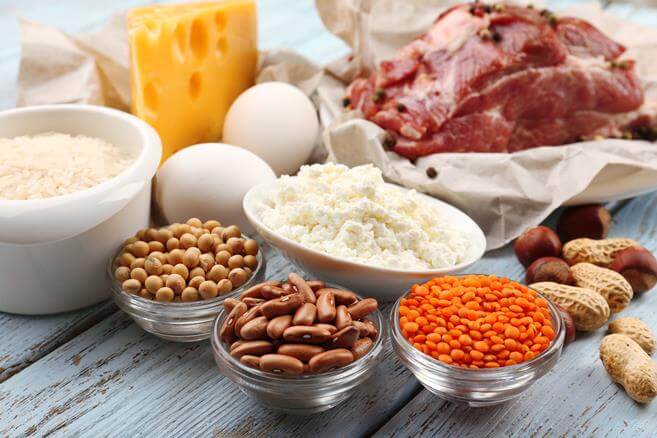
There is also a lot of protein found in foods such as:
- various types of meat - chicken and turkey, beef, rabbit and venison;
- fish and seafood - salmon, tuna, mackerel, pike, bream, squid, shrimp, etc.;
- vegetables and fruits – avocado, banana, asparagus, spinach;
- legumes - chickpeas, peas, beans, soybeans;
- nuts and seeds – almonds, walnuts and Brazil nuts, hazelnuts, pumpkin and sunflower seeds;
- fermented milk products – cottage cheese, sour cream, cheese;
- chicken eggs.
Fats in Chicken Breast
White chicken meat is the basis of most diets, due to the low fat content of the product. The largest amount of it is in the skin, so if the breast is without it, then the dish becomes completely safe for the figure. Replenishment of the daily requirement for the fat element is only 3% per person under 50 years of age with moderate activity.
Fat content in uncooked chicken breast = 1.9 g, same amount in cooked meat.
When frying and baking with oil, the indicator increases. In the first case - up to 7 g, in the second - up to 5.5 g. Athletes choose chicken for daily nutrition, since other types of meat (pork, lamb), with a similar protein content, include much more fat.
Easy and simple preparation of chicken breast
Chicken meat can be prepared in the following ways:
- bake in the oven in foil, a special baking bag or dish;
- fry or stew;
- boil or steam.
If fried, the calorie content of this type of meat will be higher, but the method is considered the simplest and fastest. Often before frying, fillets are lightly beaten so that the resulting steaks are evenly cooked. Cooking time for this tender meat is sear for 4 minutes on each side.

Boiling or stewing chicken takes longer. Boiled chicken meat becomes boring very quickly, so in this form it is used mainly as an ingredient for salad.
Recipes
Any recipe for cooking poultry meat is quite simple and accessible, and if cooked correctly it will be soft and tasty. Therefore, if you think that the dish will turn out dry and tasteless, then simply follow the recipe and monitor the cooking time to avoid such consequences.
Chicken goes well with any side dish, be it cereals, legumes or vegetables. Another advantage is that breast gets along well with any fermented milk product.
Recipe No. 1. Chicken fillet in sour cream
Tips for cooking chicken fillet
- In order for the meat to develop a crispy crust during cooking, it should be soaked in salt water for about 30 minutes;
- to make it soft, it is first recommended to marinate the breast in any sauce for 1-2 hours;
- To prevent a frozen product from becoming dry during cooking, it must be thoroughly defrosted;
- Do not cook the ingredient over high heat, because... this will make it dry. To obtain a crispy crust, it is enough to increase the temperature only at the end of cooking;
- adding baking powder to the marinade will also crisp up the crust without changing the flavor of the product.
As you have seen, chicken fillet is a very protein-rich meat that will be an excellent ingredient in any dish for both those losing weight and those gaining muscle mass, adding variety to the lunch menu. Include only the most delicious and healthy foods in your diet and be healthy!
